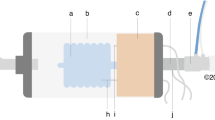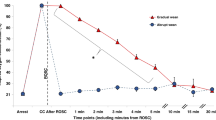Abstract
Objective
Updated neonatal resuscitation guidelines for free-flow oxygen administration with a T-piece resuscitator recommend higher gas flow and an open T-piece cap. We aimed to determine the effect of gas inflow rate and cap occlusion on oxygen delivery through a T-piece resuscitator.
Study design
Using a NeoPuff™ T-piece, oxygen inflow was randomly adjusted from 4 to 10 liters per minute (LPM). Gas outflow and oxygen concentration were measured with the T-piece cap open and occluded. Data were analyzed with repeated measures 2-way ANOVA.
Result
Gas outflow was significantly decreased with the T-piece cap open compared with occluded at each inflow rate (p < 0.001). There was no difference in oxygen concentration of the outflow gas.
Conclusion
Gas flow from the T-piece is affected by the inflow rate and cap occlusion but oxygen concentration is not. To deliver 5 LPM of free-flow oxygen with the cap open, a minimum of 8 LPM gas inflow is required.
This is a preview of subscription content, access via your institution
Access options
Subscribe to this journal
Receive 12 print issues and online access
$259.00 per year
only $21.58 per issue
Buy this article
- Purchase on Springer Link
- Instant access to full article PDF
Prices may be subject to local taxes which are calculated during checkout

Similar content being viewed by others
References
Wykoff MH, Aziz K, Escodedo BM, Kapadia VS, Kattwinkel J, Perlman JM, et al. Part 13: Neonatal resuscitation. 2015 American Heart Association guidelines update for cardiopulmonary resuscitation and emergency cardiovascular care (reprint). Pediatrics. 2015;136(Suppl 2):S196–218.
Trevisanuto D, Satariano I, Doglioni N, Criscoli G, Cavallin F, Gizzi C, et al. Changes over time in delivery room management of extremely low birth weight infants in Italy. Resuscitation. 2014;85:1072–6.
Guinsburg R, de Almeida MFB, de Castro JS, Goncalves-Ferri WA, Marques PF, Caldas JPS, et al. T-piece versus self-inflating bag ventilation in preterm neonates at birth. Arch Dis Child Fetal Neonatal Ed. 2018;103:F49–F55.
Mann C, Ward C, Grubb M, Hayes-Gill B, Crowe J, Marlow N, et al. Marked variation in newborn resuscitation practice: A national survey in the UK. Resuscitation. 2012;83:607–11.
Bennett S, Finer NN, Rich W, Vaucher Y. A comparison of three neonatal resuscitation devices. Resuscitation. 2005;67:113–8.
Weiner GM, Zaichkin J, Kattwinkel J, American Academy of Pediatrics, Association AH. Textbook of Neonatal Resuscitation, 7th edition. Elk Grove Village, IL, USA: American Academy of Pediatrics, 2016.
Dawson JA, Davis PG, Kamlin CO, Morley CJ. Free-flow oxygen delivery using a T-piece resuscitator. Arch Dis Child Fetal Neonatal Ed. 2007;92:F421.
Lyew MA, Holland AJ, Metcalf IR. Combined air and oxygen entrainment. Effect on the percentage output of fixed performance masks. Anaesth. 1990;45:732–5.
Strand M, Zaichkin J. Administering free-flow oxygen with the T-piece resuscitator. NRP Instructor Update. 2017;26:1.
Hawkes CP, Oni OA, Dempsey EM, Ryan CA. Potential hazard of the Neopuff T-piece resuscitator in the absence of flow limitation. Arch Dis Child Fetal Neonatal Ed. 2009;94:F461–463.
Hawkes CP, Dempsey EM, Ryan CA. The Neopuff’s PEEP valve is flow sensitive. Acta Paediatr. 2011;100:360–3.
Hinder M, McEwan A, Drevhammer T, Donaldson S, Tracy MB. T-piece resuscitators: How do they compare? Arch Dis Child Fetal Neonatal Ed. 2019;104:F122–F127.1.
Acknowledgements
We would like to thank Tony Iannetta, RRT for his assistance with set up of the testing devices.
Author information
Authors and Affiliations
Corresponding author
Ethics declarations
Conflict of interest
The authors declare that they have no conflict of interest.
Additional information
Publisher’s note: Springer Nature remains neutral with regard to jurisdictional claims in published maps and institutional affiliations.
Rights and permissions
About this article
Cite this article
Ellsworth, L., Meerkov, M., Doglioni, N. et al. Oxygen supplementation in the delivery room: T-piece resuscitator cap open or occluded?. J Perinatol 39, 1078–1080 (2019). https://doi.org/10.1038/s41372-019-0406-x
Received:
Revised:
Accepted:
Published:
Issue Date:
DOI: https://doi.org/10.1038/s41372-019-0406-x



